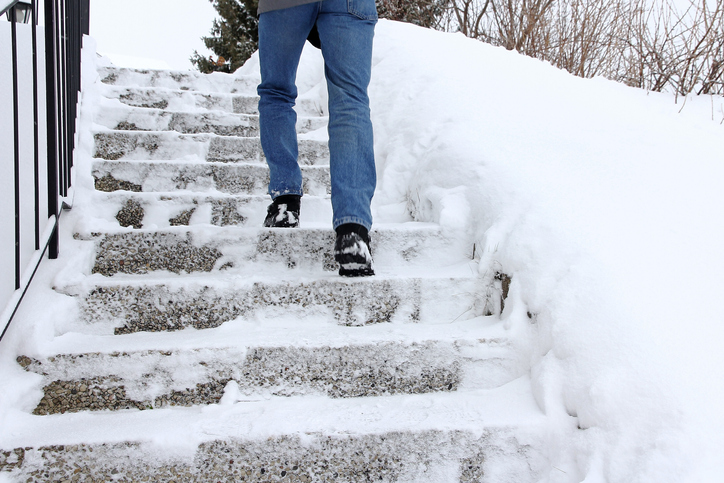Winters in Chicago are some of the coldest in the U.S. With the cold, blustery weather comes an increased risk of slip and fall accidents, especially in parking lots and walkways. While slip and falls happen during every season, they tend to be more prevalent during the winter months. Walking areas easily become dangerous due to ice, slush and snow.
According to the Centers for Disease Control and Prevention (CDC), about one in every five slip and fall accidents results in a serious injury, such as a bone fracture or concussion. It’s also common to sustain spinal injuries, soft tissue injuries and internal injuries in falls.
The attorneys at Coplan & Crane discuss the course of action you should take after a slip and fall, as well as what you can expect from your case. Here’s what you need to know.
Reporting your slip and fall
If you were involved in a slip and fall accident, it’s absolutely critical that you report the incident to a store manager or property owner. Be sure to include the details in writing, such as the date, time and location of the incident, as well as the hazard that caused it. This is one of the strongest pieces of evidence you have to build a strong slip and fall case.
Failing to report a slip and fall accident in a timely manner can make it very difficult to build a case. There are two reasons for this:
- Evidence can quickly disappear and it can be difficult to prove that your slip and fall occurred where and when you claim it did.
- The insurance companies and their lawyers can argue that your aches and pains were unrelated to the incident.
The only time you don’t need to immediately report your slip and fall is if you were severely injured and had to call 911. An emergency response such as this can provide sufficient evidence that your slip and fall accident occurred when and where you say it did. It can also provide enough evidence that you were severely injured. The same could also apply if you drove directly to the emergency room and reported the incident to a nurse or doctor.
Other ways to help build a strong slip and fall case
You can also build a strong case by:
- Taking pictures of the hazard that led to your fall. Be sure to capture the slipping or tripping hazards from as many angles as possible.
- Speaking to witnesses. Ask nearby witnesses what they saw and exchange contact information with them.
- Take note of nearby surveillance cameras. If there were any surveillance cameras anywhere on the premises, be sure to take note of them. An attorney may be able to obtain the footage, but it would have to be done quickly. Video footage can easily be overwritten or deleted.
Getting medical attention
If you’re not immediately rushed to the emergency room after a slip and fall, it’s still critical that you see a doctor as soon as possible. Even if you don’t feel immediate pain, a medical evaluation may reveal that you suffered an injury. It could be a spinal injury, soft tissue injury, head injury or hairline fracture.
Failing to get prompt medical attention can give the insurance companies more leverage against your case. They can argue that your injuries are exaggerated or pre-existing. With a proper medical evaluation and diagnosis, it will be much easier to link your injury to the slip and fall.
Proving causation in a slip and fall case
There are several important factors that go into proving a slip and fall or premises liability case. First, your reason for being on the property must be established. If you were invited onto the property or the property was open to the public, then the owner or manager had a legal obligation to reasonably address all slip and fall hazards. On the other hand, if you were injured while trespassing on someone’s property, then you have fewer rights.
Secondly, the type of hazard must be established. For example, your slip and fall may have been caused by unaddressed:
- Ice and/or snow
- Water tracked in from outside
- Spilled liquids
- Unsecured rugs
- Loose debris on the ground
Most importantly, the level of knowledge the property owner had of the hazard must be established. For example, if you slipped and fell on an icy walkway, it must be proven that the owner or manager:
- Had knowledge of the ice on the walkway, but did nothing to address it.
- Should have had knowledge of the ice on the walkway due to the amount of time it was there.
It will be difficult to prove that the property owner or manager was negligent if they weren’t given a reasonable amount of time to address a slipping hazard. For example, you slipped and fell in a grocery store moments after another customer spilled a liquid.
Why hire a Chicago personal injury lawyer?
Getting compensated after a slip and fall accident won’t be easy. An investigation needs to be conducted to link your injuries to the property owner’s negligence. In addition, an accurate value on your case must be determined. This can take some time, but it’s worth the wait to build a strong case and recover every dollar you deserve in damages. An experienced Chicago personal injury lawyer at Coplan + Crane will work with you every step of the way.
We can help you recover medical expenses (both current and future), lost wages, assistance with daily tasks, pain and suffering, and loss of enjoyment of life. Our legal team would be glad to sit down with you during your free case evaluation and discuss the details surrounding your claim. There is no pressure to hire us to handle your case, just answers to any legal questions you have. If you decide to hire us, you won’t be charged for our services unless we win your case. To learn more, contact us online or call us.
















